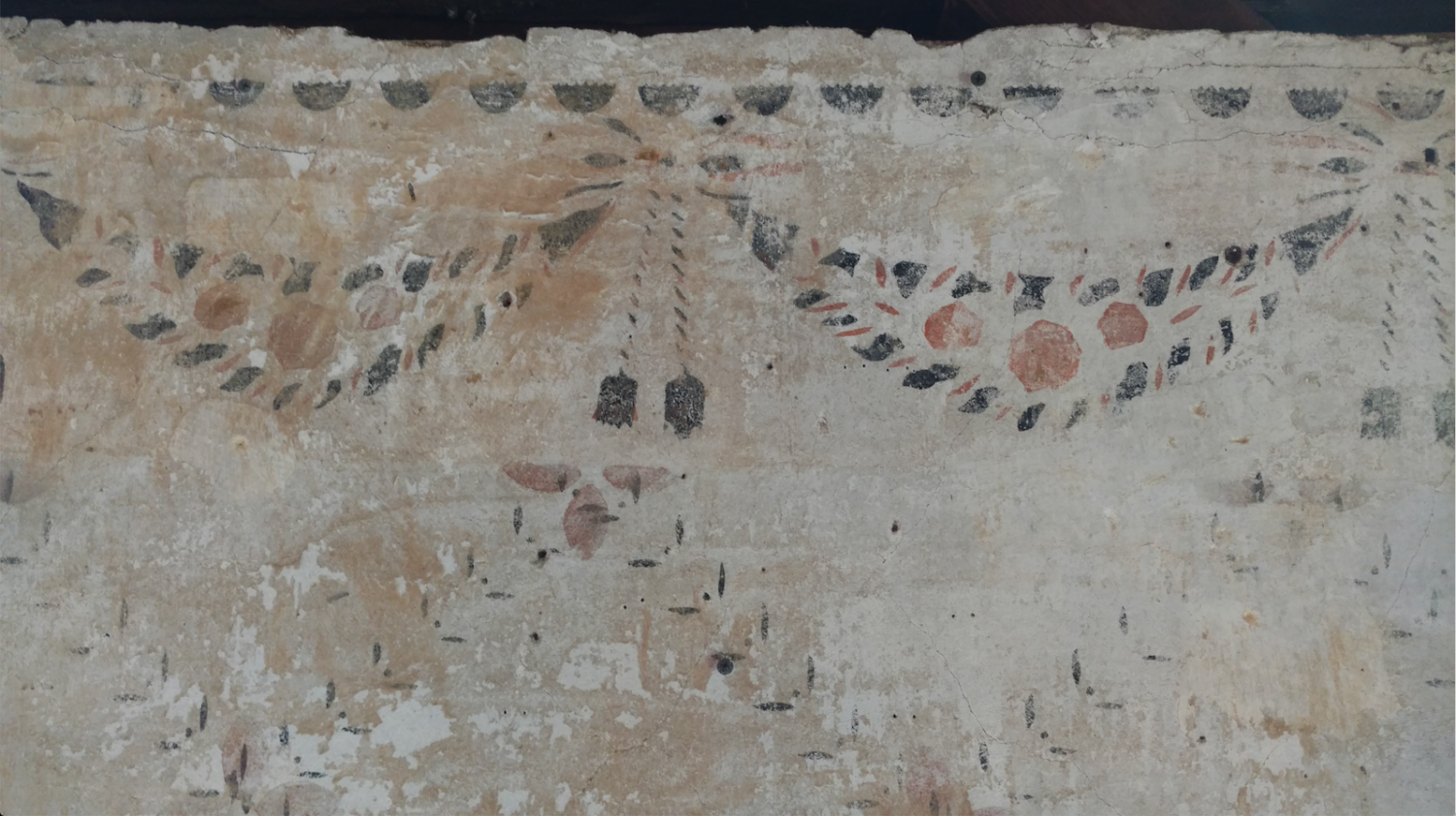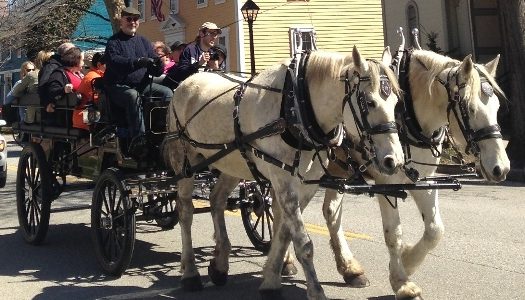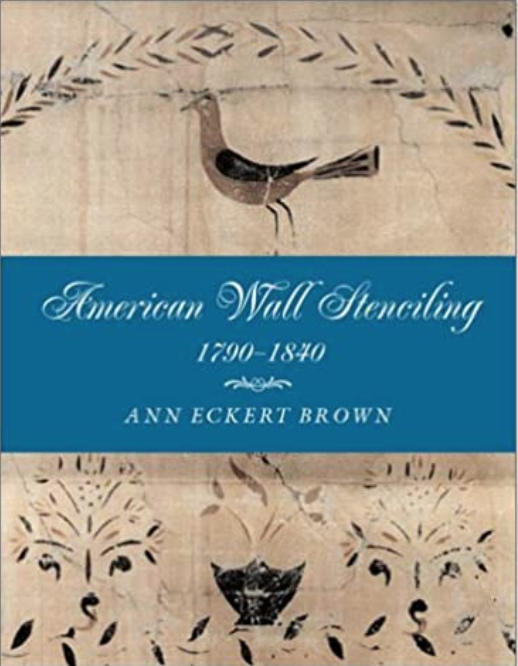Researching stenciled decorations found on walls of historic American homes must be similar to investigating the cold cases tackled by today’s television detectives. In both such investigations, there are many difficult questions to research and answer. One big difference is, however, the age of the case, with TV cases being perhaps no more than twenty-five to fifty years, while American wall stenciling mysteries are often around 200 or more years old. With the passing of the years, many pertinent clues have vanished. For me, as well as TV detectives, the most challenging and essential question is, “Who dun it?”
Affixing a name to the creator of 200-year-old art work, typically found under a thick layer of wallpaper by unsuspecting new owners of historic houses, is a harrowing task. In addition, sadly, many, if not most, of the elusive itinerant artisans failed to sign their work or, if they did, that evidence too has disappeared with age.
Some years ago, I reluctantly filed away a wall stencil cold case because I was completing my first book on early American architectural wall painting, American Wall Stenciling, 1790-1840 (University Press of New England, 2003). In 2003, my husband, A. L. Brown, and I, were taken to Loudon, New Hampshire to see a house built on Clough Hill in Loudon, New Hampshire, built by Jonathan Clough in 1790. The house contained (and I hope still does) nicely preserved stenciling, with the greatest treasure in the second floor front bed chamber. There between two front windows was a fine stenciled panel featuring the two perky red and black birds perched on a stylized flower-filled vase. The image was well preserved by the shade of an old maple tree. I eagerly snapped a photograph of it. I liked it so much that I made it the cover of the book. I set aside identifying the artist because the book was already well into production.
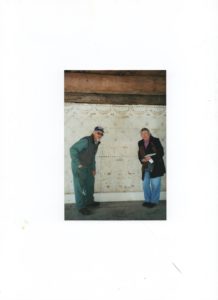
Ann Eckert Brown, with the then owner of the Clough House, Joseph Hodgson, standing in front of a wall mural at the Clough House in Loudon, New Hampshire
The case was recently reopened when I received an email from Ken in Loudon, New Hampshire, with the message, “trying to contact Ann Eckert Brown about wall stenciling in a house in Loudon, NH. It appears in her book American Wall Stenciling.” When I opened the picture attachment in the email, I was startled to see an image that was similar to one I saw in person about 15 years ago—it looked a lot like the one that appears on the cover of my first wall stenciling book published in 2003.
Ken’s image showed two perky red and black birds framing a majestic eagle, with the inscription G.W. 32. The initials are probably George Washington’s initials and birth date. The image was found in a second-floor bedchamber. The wall stencil seems to be an obvious nod to Washington’s 1789 trip through three New England states, which were the first to ratify the U.S. Constitution (Massachusetts, Connecticut, and New Hampshire).
Several other houses in Loudon and neighboring towns have stenciling by this same itinerant artist. I did not know, and no one else knew, his formal name. Thus, I dubbed him the Birdman of Loudon, New Hampshire. While some of his wall stencils have been discovered, I suspect a goodly number are still hidden behind wallpaper.
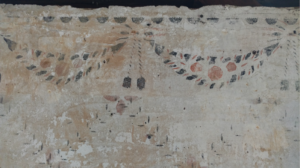
Three roses and tassel frieze (border at the ceiling) at the Clough House in Loudon, New Hampshire (the author)
While researching my third book, Painted Rooms of Rhode Island, Colonial and Federal (Spring Green Books, 2012), my interest was piqued by a group of houses that seemed to have stencil designs very similar to those used by my Birdman, including the “3 rose and tassel” frieze. The dates of the houses also were similar to those in Loudon, late eighteenth to early nineteenth century.
The houses containing the stencils were in the port of Wickford, located on the west side of Narragansett Bay. During the Revolutionary War, it had been a haven for prominent Newport citizens intent on escaping the British occupation. By the 1790s, Wickford experienced a period of great growth as a port and shipbuilding center, second only to Newport and Providence.
Stenciling dating to the 1790s has been found in several houses built on Wickford’s Main Street by the port’s favorite housewright, Robert Potter. In addition, a tavern where Benjamin Franklin reportedly once stayed had Birdman-like stenciling in its entryway. I believe numerous stenciled walls that have yet to be discovered are currently in houses in Wickford.
My primary goal was to discover the name of the Birdman. My search for the name of the artist began with a search of newspapers advertisements, which can be important aids identifying early stencil artists, who many times were itinerants advertising in local papers when they moved into a new area. I spent many hours viewing microfilm of newspapers at the Rhode Island Historical Society Library in Providence, seeking ads that corresponded to date range for the stenciling (as mentioned, from the late eighteenth century through the early next century). My efforts produced two advertisements with two names that could be the Birdman! I was surprised I found more than one name, considering the small number of wall stencil artists who have been recorded in the entire country.
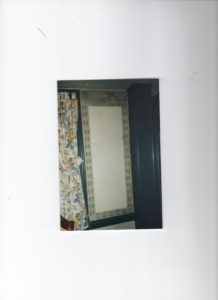
Three roses and tassel frieze at the Potter house on Main Street, Wickford. This vertical border was also used by the Birdman in Loudon, New Hampshire (the author)
The first advertisement was placed by John Woodberry in 1796 in the United States Chronicle, a newspaper then published in Providence. Woodberry indicated that he wished to paint “walls in imitation of paper hangings” (that is, wallpaper) and to paint “Carpets in the European Style.” Several stenciled floors of the correct time frame (including the famous First Baptist Church in Providence) have been found in the Providence area that could have been executed by Woodberry.
The second advertisement was placed by D. Bartling from Philadelphia. He advertised in 1799 in a Providence newspaper that he was offering to do “ornamental painting of all kinds.” I was familiar with Bartling, who had advertised in Boston earlier. I was aware that by 1804 he was advertising in New Haven, Connecticut, just down the coast by land or sea from Wickford. Included in the ornamental painting techniques he offered in the New Haven advertisement was “imitation of stamped paper,” a reference to wallpaper.
Thus, Rhode Island, the smallest state in the Union, had not one but two candidates who could be the Birdman of Loudon. After going over facts that I uncovered, I concluded that Bartling was my man!
I was tickled with the idea that the artist whose work I had so admired in New Hampshire probably also visited my home state of little Rhody. However, I am disappointed that I could not find his signature on a wall in either New Hampshire or Rhode Island. Without such a finding, I cannot definitely attribute the wall stencils in Wickford to Bartling. But I am 99.9 percent sure that he was the artist.
[Banner image: Three roses and tassel frieze (border at the ceiling) at the Clough House in Loudon, New Hampshire (the author)]

